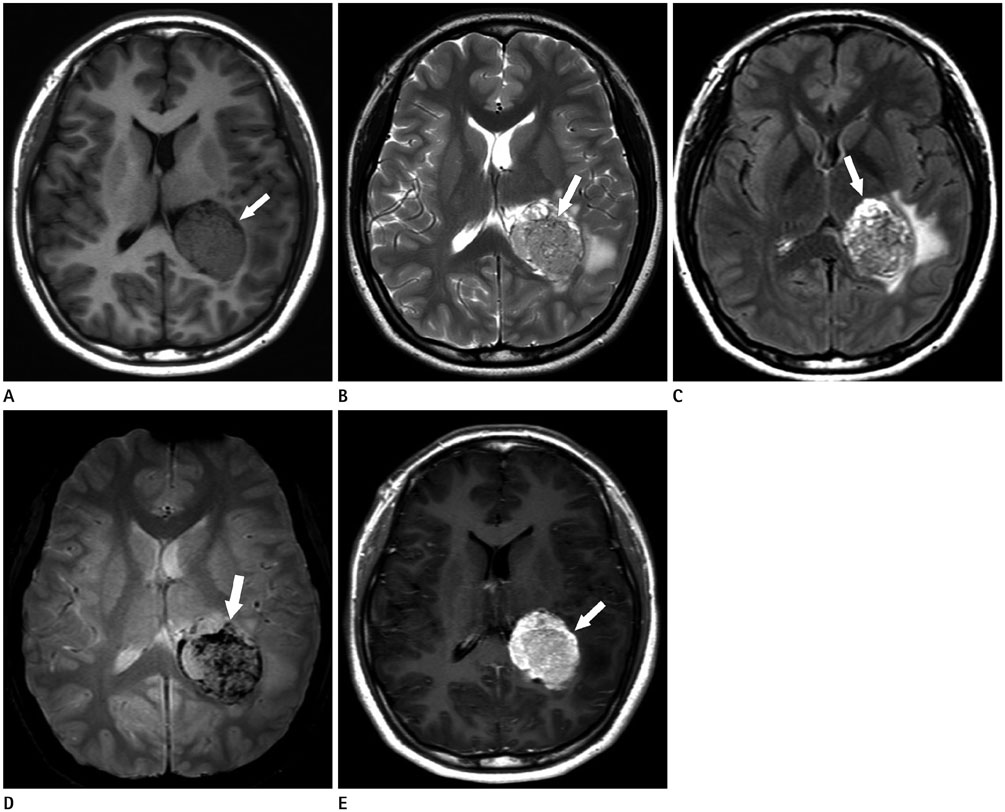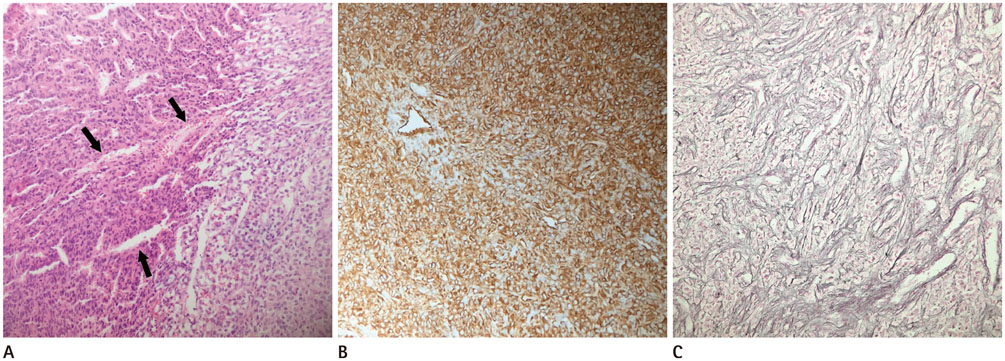J Korean Soc Radiol.
2016 Sep;75(3):222-226. 10.3348/jksr.2016.75.3.222.
Intraventricular Anaplastic Hemangiopericytoma: CT and MR Imaging Findings
- Affiliations
-
- 1Department of Radiology, Gyeongsang National University School of Medicine, Gyeongsang National University Changwon Hospital, Changwon, Korea. drlotus@naver.com
- KMID: 2349330
- DOI: http://doi.org/10.3348/jksr.2016.75.3.222
Abstract
- Intracranial hemangiopericytomas (HPC) are uncommon tumors, and their intraventricular occurrence is even rarer. Although the histopathologic findings in HPC are distinct, the diagnosis of intraventricular HPC can be difficult owing to its rarity and nonspecific clinicoradiologic manifestations. Here we present a case of intraventricular anaplastic HPC in a 20-year-old female patient, confirmed on histopathologic examination. We suggest that HPC should be considered in the differential diagnosis of space-occupying lesions of the ventricles. This article also highlights a situation in which clinical suspicion led to a meticulous radiologic review.
MeSH Terms
Figure
Reference
-
1. Muller J, Mealey J Jr. The use of tissue culture in differentiation between angioblastic meningioma and hemangiopericytoma. J Neurosurg. 1971; 34:341–348.2. Brunori A, Delitala A, Oddi G, Chiappetta F. Recent experience in the management of meningeal hemangiopericytomas. Tumori. 1997; 83:856–861.3. Rutkowski MJ, Sughrue ME, Kane AJ, Aranda D, Mills SA, Barani IJ, et al. Predictors of mortality following treatment of intracranial hemangiopericytoma. J Neurosurg. 2010; 113:333–339.4. Avinash KS, Thakar S, Ghosal N, Hegde AS. Anaplastic hemangiopericytoma in the frontal horn of the lateral ventricle. J Clin Neurosci. 2016; 26:147–149.5. Towner JE, Johnson MD, Li YM. Intraventricular hemangiopericytoma: a case report and literature review. World Neurosurg. 2016; 89:728.e5–728.e10.6. Desai K, Nadkarni T, Fattepurkar S, Goel A, Shenoy A, Chitale A, et al. Hemangiopericytoma in the trigone of the lateral ventricle--case report. Neurol Med Chir (Tokyo). 2004; 44:484–488.7. Chiechi MV, Smirniotopoulos JG, Mena H. Intracranial hemangiopericytomas: MR and CT features. AJNR Am J Neuroradiol. 1996; 17:1365–1371.8. Rutkowski MJ, Jian BJ, Bloch O, Chen C, Sughrue ME, Tihan T, et al. Intracranial hemangiopericytoma: clinical experience and treatment considerations in a modern series of 40 adult patients. Cancer. 2012; 118:1628–1636.9. Sumi K, Watanabe T, Ohta T, Fukushima T, Kano T, Yoshino A, et al. Hemangiopericytoma arising in the body of the lateral ventricle. Acta Neurochir (Wien). 2010; 152:145–149. discussion 150.10. Tanaka T, Kato N, Arai T, Hasegawa Y, Abe T. Hemangiopericytoma in the trigone of the lateral ventricle. Neurol Med Chir (Tokyo). 2011; 51:378–382.
- Full Text Links
- Actions
-
Cited
- CITED
-
- Close
- Share
- Similar articles
-
- Detection of Acute Intraventricular Hemorrhage: Comparison of FLAIR MR Imaging with Unenhanced CT
- CT and MRI Findings of Intraventricular Neurocytoma
- Comparison of Fluid-Attenuated Inversion-Recovery Magnetic Resonance Imaging with Computed Tomography in Acute Intraventricular Hemorrhage
- Magnetic resonance imaging of intracranial cysticercosis: comparison with computed tomography
- CT and Magnetic Resonance Imaging Findings of Lipomatous Hemangiopericytoma of Skull Base: A Case Report





